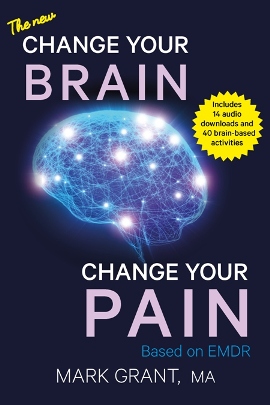Buy on Amazon
Kindle eBooks
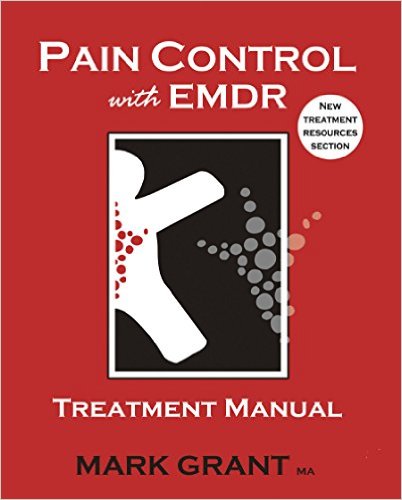 The 5th revised edition of this research-based manual describes how to use EMDR in the treatment of chronic pain. Includes a review of role of trauma and attachment problems in pain, neurological aspects of pain, Theoretical model of pain based on Accelerated Information Processing Model, step by step EMDR pain protocol, including detailed notes and tips for each stage, key differences between trauma protocol and pain protocol, advice about common blockages and how to deal with them, how to enhance client responsiveness to bilateral stimulation, how to develop strong affect-based resources for coping with on-going pain, adjunctive strategies and resources, assessment tools, information about dissociation and pain, numerous case-examples, and over 30 pages of photocopyable treatment aids and resources. After PTSD, pain is the most researched application of EMDR. 240 pages.
The 5th revised edition of this research-based manual describes how to use EMDR in the treatment of chronic pain. Includes a review of role of trauma and attachment problems in pain, neurological aspects of pain, Theoretical model of pain based on Accelerated Information Processing Model, step by step EMDR pain protocol, including detailed notes and tips for each stage, key differences between trauma protocol and pain protocol, advice about common blockages and how to deal with them, how to enhance client responsiveness to bilateral stimulation, how to develop strong affect-based resources for coping with on-going pain, adjunctive strategies and resources, assessment tools, information about dissociation and pain, numerous case-examples, and over 30 pages of photocopyable treatment aids and resources. After PTSD, pain is the most researched application of EMDR. 240 pages.
Based on the latest insights from brain science, the new revised edition of ‘Change Your Brain Change Your Pain’ offers a combination of insightful information and practical real-world strategies for reversing the brain activity which maintains chronic pain.
Based on the authors 20 years of clinical experience and research using Eye Movement Desensitization & Reprocessing (E.M.D.R) to treat pain, this book shows how to harness natural brain capacities such as attention, memory and sensory processing to change the brain activity which maintains pain. The author turned to E.M.D.R. after feeling dissatisfied with the results obtained using traditional methods, especially their general inability to effect the somatic element of chronic pain.
This book brings together elements from many different approaches, plus bilateral stimulation, to create a comprehensive set of strategies which target multiple aspects of brain functioning. Bilateral stimulation is a bottom-up treatment element of E.MD.R. Research indicates that bilateral stimulation can change brain activity associated with pain (and trauma) more effectively. Psychologically bilateral stimulation stimulates decreased physiological arousal, decreased emotional distress, increased feelings of well-being etc. Although bilateral stimulation is a core element of one of the most powerful trauma therapies, like many elements of other treatment approaches, it appears that it can be safely used as a take-home strategy under non-therapeutic conditions.
Delving beneath the psychological experience of pain, the book begins by explaining how the brain works and how pain gets into the brain in a very simple, easy to understand way (you can’t solve a problem unless you understand it). This information is then combined with a holistic view of the physical and emotional effect of pain to create a brain-based map of the 7 key steps necessary for overcoming pain (e.g. taming the pain, managing emotional distress, trauma processing, identity issues etc). The 7-steps are fulfilled via 15 brain-smart strategies (8 x bottom-up and 7 x top-down). Each strategy targets a particular aspect of brain activity as it relates to pain. Because the steps are sequenced in the same order in which the brain processes information (sensory – emotional – cognitive) the change process is intuitive and natural. For example, rather than trying to out-think the pain, imagine finding relief after focusing on the pain plus bilateral stimulation (bottom-up) and then developing new positive beliefs (e.g. ‘I can control my pain’) based on feeling better (top-down). That’s how your brain really learns!
The new Change Your Brain Change Your Pain includes;
• How to understand your pain in terms of how your brain works.
• How to match pain-related problems onto brain activity and choose strategies that target the brain activity involved.
• 15 x brain-smart bottom-up and top down strategies for overcoming pain.
• 40 x activities for reversing the various physical and emotional effects of chronic pain.
• 15 x guided audio self-help exercises (2 hours of audio downloads).
• Updated information on the connection between stress and pain (e.g. trauma, and attachment problems).
Mark Grant is a psychologist with 20 years experience treating sufferers of physical and emotional pain. He has conducted research regarding as a treatment for chronic pain. He has also published a treatment manual and self-help CD’s. His app ‘anxiety release based on E.M.D.R’ resulted in the first documented case of an app being used to alleviate physical discomfort associated with chronic pain. Download Chapter 1
Paperbacks on Amazon
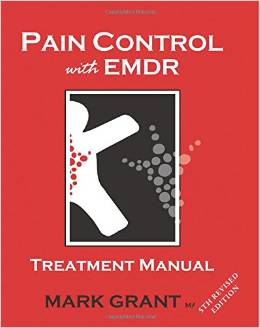 The 5th revised edition of this research-based manual describes how to use EMDR in the treatment of chronic pain. Includes a review of role of trauma and attachment problems in pain, neurological aspects of pain, Theoretical model of pain based on Accelerated Information Processing Model, step by step EMDR pain protocol, including detailed notes and tips for each stage, key differences between trauma protocol and pain protocol, advice about common blockages and how to deal with them, how to enhance client responsiveness to bilateral stimulation, how to develop strong affect-based resources for coping with on-going pain, adjunctive strategies and resources, assessment tools, information about dissociation and pain, numerous case-examples, and over 30 pages of photocopyable treatment aids and resources. After PTSD, pain is the most researched application of EMDR. 240 pages. Visit Amazon page
The 5th revised edition of this research-based manual describes how to use EMDR in the treatment of chronic pain. Includes a review of role of trauma and attachment problems in pain, neurological aspects of pain, Theoretical model of pain based on Accelerated Information Processing Model, step by step EMDR pain protocol, including detailed notes and tips for each stage, key differences between trauma protocol and pain protocol, advice about common blockages and how to deal with them, how to enhance client responsiveness to bilateral stimulation, how to develop strong affect-based resources for coping with on-going pain, adjunctive strategies and resources, assessment tools, information about dissociation and pain, numerous case-examples, and over 30 pages of photocopyable treatment aids and resources. After PTSD, pain is the most researched application of EMDR. 240 pages. Visit Amazon page The NEW CHANGEYOUR BRAIN CHANGE YOUR PAIN (2016)
Based on the latest insights from brain science, the new revised edition of ‘Change Your Brain Change Your Pain’ offers a combination of insightful information and practical real-world strategies for reversing the brain activity which maintains chronic pain.
Based on the authors 20 years of clinical experience and research using Eye Movement Desensitization & Reprocessing (E.M.D.R) to treat pain, this book shows how to harness natural brain capacities such as attention, memory and sensory processing to change the brain activity which maintains pain. The author turned to E.M.D.R. after feeling dissatisfied with the results obtained using traditional methods, especially their general inability to effect the somatic element of chronic pain.
This book brings together elements from many different approaches, plus bilateral stimulation, to create a comprehensive set of strategies which target multiple aspects of brain functioning. Bilateral stimulation is a bottom-up treatment element of E.MD.R. Research indicates that bilateral stimulation can change brain activity associated with pain (and trauma) more effectively. Psychologically bilateral stimulation stimulates decreased physiological arousal, decreased emotional distress, increased feelings of well-being etc. Although bilateral stimulation is a core element of one of the most powerful trauma therapies, like many elements of other treatment approaches, it appears that it can be safely used as a take-home strategy under non-therapeutic conditions.
Delving beneath the psychological experience of pain, the book begins by explaining how the brain works and how pain gets into the brain in a very simple, easy to understand way (you can’t solve a problem unless you understand it). This information is then combined with a holistic view of the physical and emotional effect of pain to create a brain-based map of the 7 key steps necessary for overcoming pain (e.g. taming the pain, managing emotional distress, trauma processing, identity issues etc). The 7-steps are fulfilled via 15 brain-smart strategies (8 x bottom-up and 7 x top-down). Each strategy targets a particular aspect of brain activity as it relates to pain. Because the steps are sequenced in the same order in which the brain processes information (sensory – emotional – cognitive) the change process is intuitive and natural. For example, rather than trying to out-think the pain, imagine finding relief after focusing on the pain plus bilateral stimulation (bottom-up) and then developing new positive beliefs (e.g. ‘I can control my pain’) based on feeling better (top-down). That’s how your brain really learns!
The new Change Your Brain Change Your Pain includes;
• How to understand your pain in terms of how your brain works.
• How to match pain-related problems onto brain activity and choose strategies that target the brain activity involved.
• 15 x brain-smart bottom-up and top down strategies for overcoming pain.
• 40 x activities for reversing the various physical and emotional effects of chronic pain.
• 15 x guided audio self-help exercises (2 hours of audio downloads).
• Updated information on the connection between stress and pain (e.g. trauma, and attachment problems).
Mark Grant is a psychologist with 20 years experience treating sufferers of physical and emotional pain. He has conducted research regarding as a treatment for chronic pain. He has also published a treatment manual and self-help CD’s. His app ‘anxiety release based on E.M.D.R’ resulted in the first documented case of an app being used to alleviate physical discomfort associated with chronic pain. Visit Amazon Page Download Chapter 1
Audio CD’s on Amazon
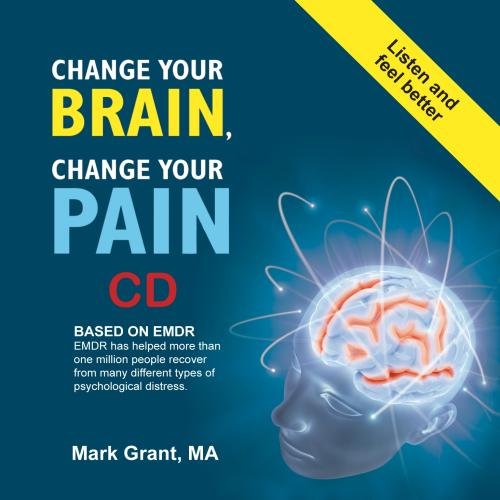 Designed for anybody who is suffering from some combination of physical and emotional pain,this CD consists of guided bilateral brain stimulation, music and focused attention to stimulate the sub cortical brain processes which maintain pain. Part of a book/CD combination of the same name This product is manufactured on demand using CD-R recordable media. Amazon.com’s standard return policy will apply. Visit Amazon page
Designed for anybody who is suffering from some combination of physical and emotional pain,this CD consists of guided bilateral brain stimulation, music and focused attention to stimulate the sub cortical brain processes which maintain pain. Part of a book/CD combination of the same name This product is manufactured on demand using CD-R recordable media. Amazon.com’s standard return policy will apply. Visit Amazon page 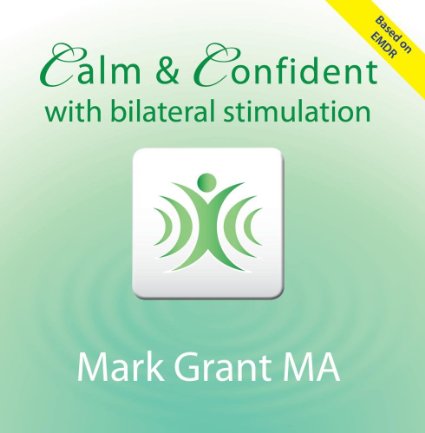 This powerful MPEG-4 quality track offers a 1 x 30 minute track of relaxation and confidence-building music and suggestions. The addition of auditory Dual Attention Stimulus and Bilateral Stimulation deactivates the conscious mind and stimulates the parasympathetic nervous system (relaxation response). Helfpful for anxiety, stress, sleeping problems, PTSD and even pain. CD format. Visit Amazon page
This powerful MPEG-4 quality track offers a 1 x 30 minute track of relaxation and confidence-building music and suggestions. The addition of auditory Dual Attention Stimulus and Bilateral Stimulation deactivates the conscious mind and stimulates the parasympathetic nervous system (relaxation response). Helfpful for anxiety, stress, sleeping problems, PTSD and even pain. CD format. Visit Amazon page  This powerful MPEG-4 quality music offers 3 x 30 minute tracks of relaxation and pain-relieving music and suggestions. The addition of auditory Dual Attention Stimulus/Bilateral Stimulation enhances the effect on the autonomic nervous system making change easy and fast. CD format. Visit Amazon page
This powerful MPEG-4 quality music offers 3 x 30 minute tracks of relaxation and pain-relieving music and suggestions. The addition of auditory Dual Attention Stimulus/Bilateral Stimulation enhances the effect on the autonomic nervous system making change easy and fast. CD format. Visit Amazon page  The Anxiety Release App is available on iTunes and Google Play. Visit the AnxietyReleaseApp.com website for more information about the App. This CD contains the soundtracks used on the Anxiety Release App to relieve anxiety – good for listening at your computer while you are working, or if you do not have a Smart Phone or Tablet to use the App. CD format Visit Amazon page
The Anxiety Release App is available on iTunes and Google Play. Visit the AnxietyReleaseApp.com website for more information about the App. This CD contains the soundtracks used on the Anxiety Release App to relieve anxiety – good for listening at your computer while you are working, or if you do not have a Smart Phone or Tablet to use the App. CD format Visit Amazon page Overcoming Pain Resources
Check out the huge library of Resources about overcoming pain.
The Blog
Read Mark’s helpful Blog Posts for helpful articles on EMDR, BLS, Pain Management and Self Help.
EMDR Workshops
Find out about upcoming workshops for those in the field of professional pain management
